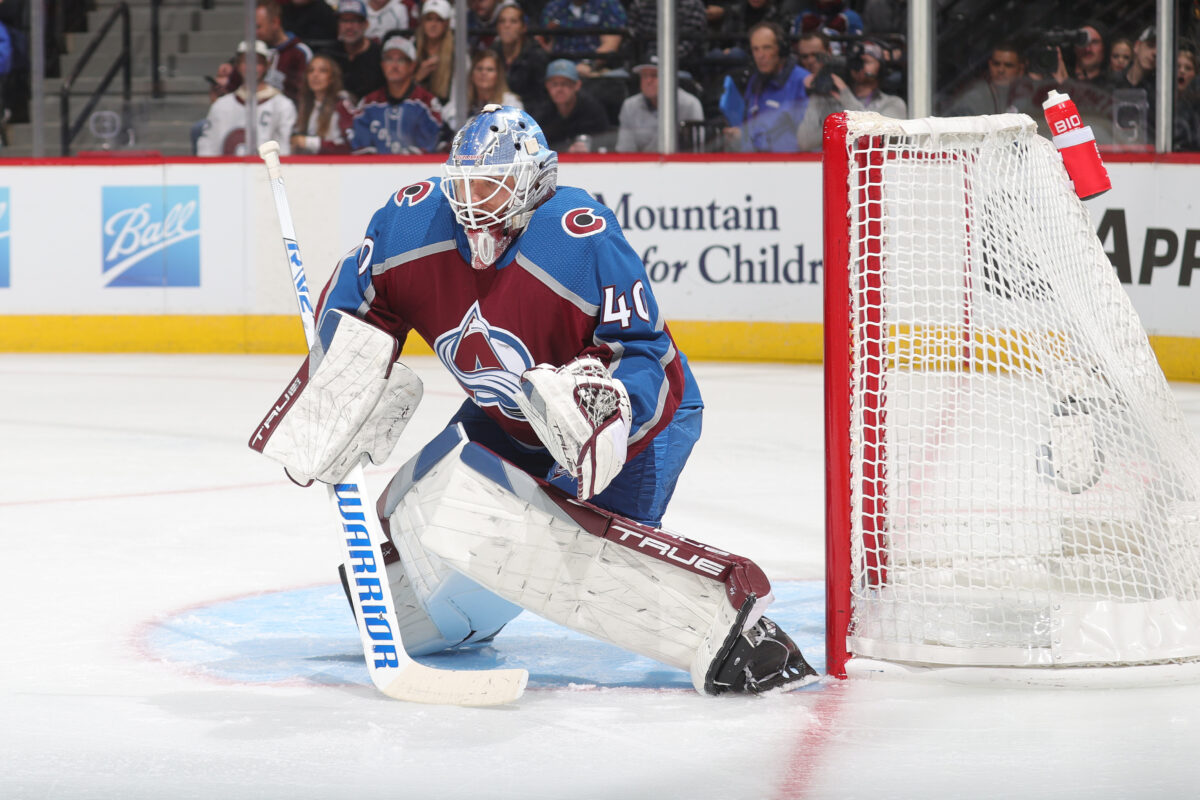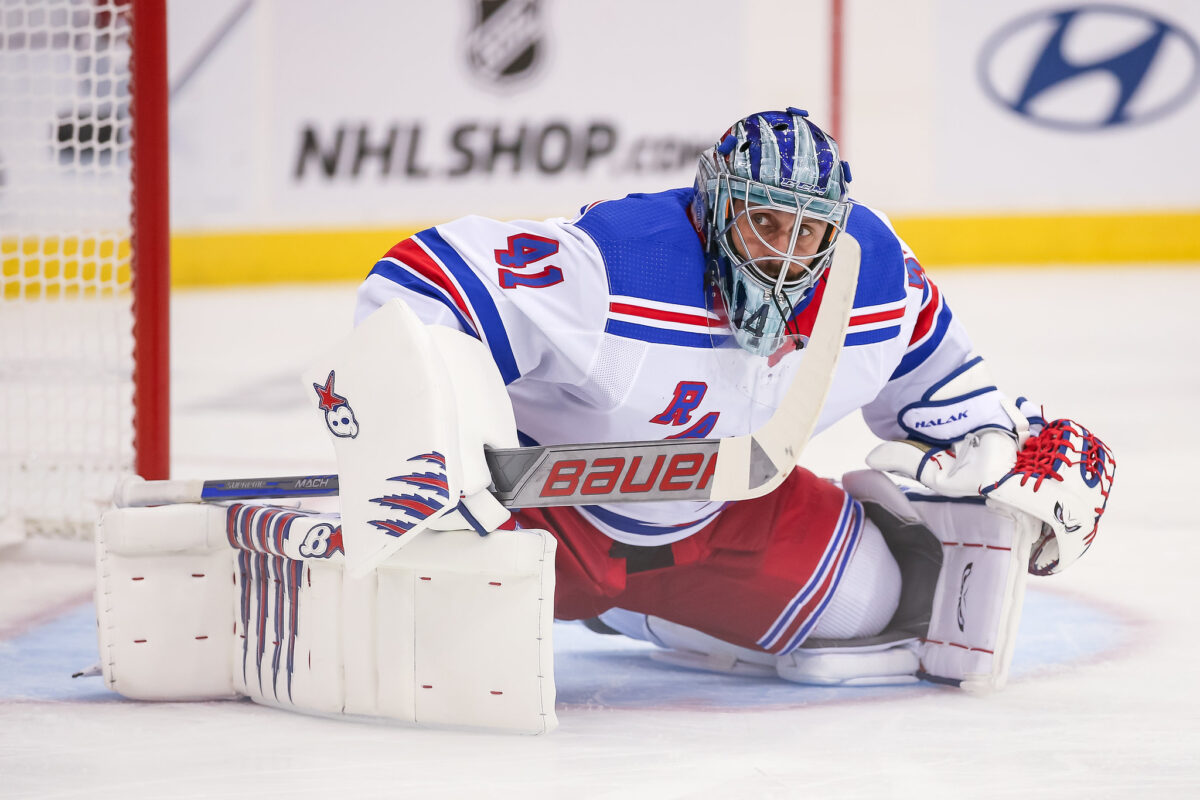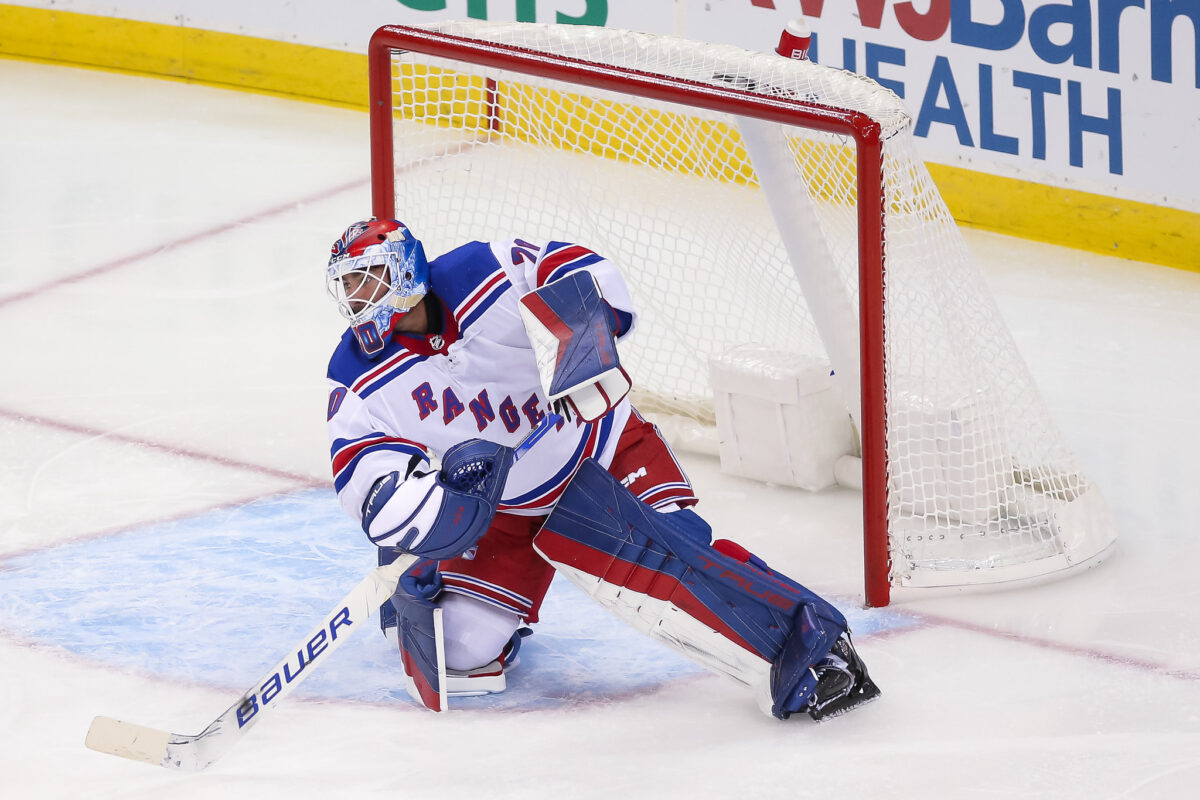The New York Rangers’ most important player was hit in the mask with a puck during practice Monday. After leaning over momentarily in pain, star goaltender Igor Shesterkin slammed his stick against the glass, an act that brought mostly relief from his team as he expressed frustration rather than any indication he was hurt.
Such incidents, however, might be more fraught with fear by the Blueshirts this season, because early results seem to suggest they’re one injury away from a worrisome situation in goal – especially if it’s for the long term.
The Colorado Avalanche invaded Madison Square Garden on Tuesday night, bringing with them offseason addition Alexandar Georgiev, who was acquired from the Rangers in July to replace the departed Darcy Kuemper in net. Georgiev was outstanding and clearly motivated against his former team in a 3-2 shootout win, making 44 saves and stopping four of five attempts in the tiebreaker.

The former Blueshirt has settled in nicely with the defending Stanley Cup champion Avs, moving to 4-0-1 with a 2.56 goals-against average and .921 save percentage into the game against the Rangers. In doing so, he’s rendered his former team’s goaltending depth unsettled.
Georgiev became something of a whipping boy for the fan base last season, as he continued to struggle in a backup role while Shesterkin ran away with the Vezina Trophy. The former undrafted free agent, who had arrived in New York two seasons before Shesterkin, also burned over what he perceived to be a less-than-equitable competition to take over for franchise icon Henrik Lundqvist, who had been eased into a lesser role during the 2019-20 season and left via contract buyout in September 2020.
Rangers Missing Georgiev’s High Ceiling Early in Season
Georgiev went 15-10-2 with a 2.92 GAA and career-worst .898 save percentage in an up-and-down performance last season. Yet those issues, which of course seemed pronounced when compared to Shesterkin’s 2021-22 brilliance, were generally understood by even his biggest detractors to be the result of a situation which Georgiev was clearly unsuited for and unhappy about.
While fans would hold their breath when they saw Georgiev making occasional starts to manage Shesterkin’s workload – one of the primary responsibilities of a backup goalie – they also understood that the club would be in generally good hands if Shesterkin were to go down with injury for a prolonged period. With regular work, Georgiev proved to be more than capable over his five seasons on Broadway, going 58-48-11 with a 2.94 GAA in 129 games overall.

Georgiev came in when Shesterkin suffered a lower-body injury in the third period against the San Jose Sharks last Dec. 3, stopping all nine shots he faced in a 1-0 victory. He then made six starts in Shesterkin’s place and allowed two or fewer goals in five of them. When Shesterkin was lost again Jan. 6, this time to COVID protocol, Georgiev took over as the Rangers embarked on a three-city western road trip. Though he didn’t play well in 5-1 loss to the Vegas Golden Knights to open that stretch, he gave up only three goals over the next two games while posting a .938 save percentage.
Georgiev isn’t Shesterkin, who last season established himself as one of the top goalies in the NHL. But when given consistent starts – which only came when Shesterkin was injured or ill the past few seasons – he was able to provide a source of comfort for his team. Georgiev’s career save percentage coming into this season was .908.
Related: Rangers Must Correct Early Season Concerns
The Rangers, of course, weren’t going to keep Georgiev after last season, and not just because his scenario in New York wasn’t workable anymore. Due a qualifying offer of at least $2.65 million as a restricted free agent, the salary cap-strapped Blueshirts were never going to be able to pay that much for a backup. General manager Chris Drury sent him to the Avs for two third-round draft picks and a fifth-rounder.
Drury then expectedly went shopping in the free-agent bargain bin and came away with 37-year-old Jaroslav Halak, who had dominated the Rangers in his career, signing him for one year at a cap-friendly $1.5 million. Though Halak has played just two games this season, he hasn’t exactly inspired confidence.

Halak has posted a 4.03 GAA and .852 save percentage in those contests. He noticeably struggled in what was a poor team-wide effort in a 5-1 home loss to the Columbus Blue Jackets on Sunday, giving up all of the goals on 21 shots. Halak has not looked technically sound in either of his outings, a disconcerting development given that he was signed to provide veteran stability behind Shesterkin.
Halak’s Sub-Par First Two Outings Creating Alarm for Rangers
Instead, the Blueshirts so far have little reason to feel good about their goaltending when their all-world netminder doesn’t play, even if it is a small sample size. That’s not sustainable, particularly because Georgiev’s inconsistency as the backup last season prompted heated debates on how long the Rangers could go with a player who was enigmatic at best when he did start.
Georgiev, however, has the ability to deliver efforts like that of March 20, when in the second game of a road back-to-back, he made 44 saves to thwart the relentless Carolina Hurricanes in a 2-0 victory. Such performances, coupled with his track record of strong play when given consistent work, in retrospect probably gave the Rangers one of the better backup goaltending situations in the league.
Can the club count on similar results from Halak this season? Again, it might be unfair to judge just yet. Halak’s career record of 285-182-64 with a 2.50 GAA and .916 save percentage for six teams suggests that he didn’t suddenly forget how to play goalie over the summer.
A couple more rough outings for Halak, however, might suggest that Father Time is catching up with him. The Rangers are a Shesterkin injury away – and the 26-year-old has dealt with several lower-body injuries in his young career – from having to turn to Halak as their No. 1 goalie for who knows how long.
Unfortunately, the internal options to potentially replace Halak aren’t great. The Rangers added 30-year-old Louis Domingue in the offseason for depth at Hartford of the American Hockey League as well as the NHL level if needed, supplanting Keith Kinkaid in that role. Domingue, though, doesn’t have Halak’s track record as a No. 1-type goalie, going 59-60-10 with a 3.04 GAA for six teams over eight years.
The club also probably isn’t interested in calling up well-regarded 20-year-old prospect Dylan Garand, a fourth-round pick in 2020 who was playing in juniors last season, to serve as a backup when he needs plenty of minor-league seasoning.
Can Halak Play for Rangers the Same Way He Played Against Them?
The Rangers couldn’t keep Georgiev, so there’s no second-guessing involved, but the loss of a 26-year-old ascending player who flashed his obvious talent in New York and is now doing so in Colorado appears to have been a bigger loss than expected. With Stanley Cup aspirations, the Blueshirts need to believe they can count on at least competent play from their backup – on a spot-starting basis, if Shesterkin were to go down for any significant length of time and to limit the star goalie’s minutes to keep him fresh for the playoffs.
The Rangers felt that they could bank on an accomplished veteran such as Halak being a low-maintenance signing. It’s not difficult to understand that, given that Halak has put forth his best efforts against the Blueshirts throughout his career, going 24-9-1 with a 2.33 GAA and .927 save percentage. That proved to be a very effective audition for a future employer, but did the front office consider that Halak might not be as good against others as he was when he saw Rangers jerseys opposing him?

That’s conjecture, at most a potential question for another time. Yet on a team that appears to be facing some early-season crises, a lack of confidence in their backup goaltender is one the Rangers can ill afford.